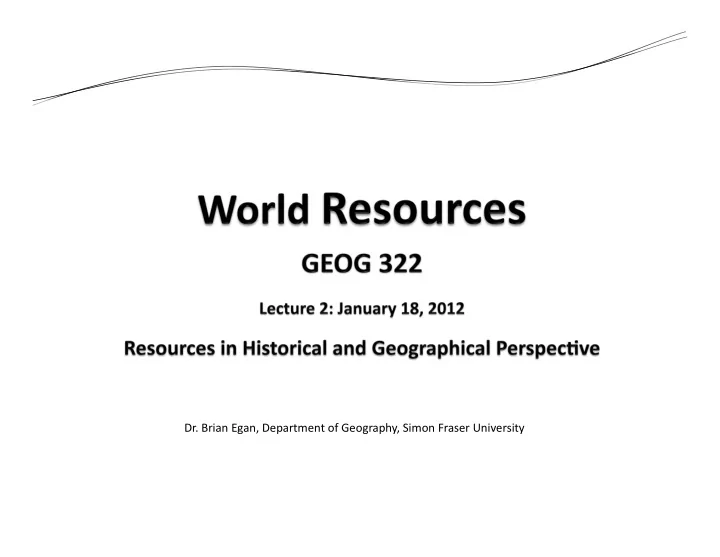

Dr. Brian Egan, Department of Geography, Simon Fraser University
overview update / review. key themes (conAnued). resources in historical and geographical perspecAve. northern gateway.
reserve readings Mather, A.S. and K. Chapman. 1995. Environmental resources . New York: PrenAce Hall. Mitchell, B. (ed.). 2004. Resource and environmental management in Canada . Toronto: Oxford University Press. Rees, J. 1985. Natural resources: alloca6on, economics, and policy . New York: Routledge. Tietenberg, T. and L. Lewis. 2006. Environmental and natural resource economics . Boston: Pearson.
student interests field trips. guest speakers from different perspecAves. films. workshop; group discussion; debate and dialogue. social and poliAcal factors; poliAcs of resource issues; poliAcal ecology. sustainable alternaAves for resource use (e.g., oil sands). local and global examples; different resource case studies. role of different actors (private sector, state, etc.).
resource scarcity absolute (Malthusian) scarcity = insufficient physical quanAAes of a resource are available to meet human demands. Lack of food leads to starvaAon, lack of water to drought. relaAve (Ricardian) scarcity = physical quanAAes of a resource exist to meet demand but problems related to quality of supply; meeAng demand requires exploiAng lower quality resources. e.g., food producAon may require farming areas poorly suited to agriculture, requiring greater effort, inputs, expenses. e.g., depleAon of easily accessible fossil fuels means focus shibs to other sources (e.g., tar sands, natural gas from fracking).
resource scarcity (categories) physical scarcity = resource supply is finite; scarcity depends on amount of resource available and level of demand; within overall limits, cycles of scarcity/abundance are possible. economic scarcity = scarcity responds to market forces (i.e., supply and demand); except if people can afford to pay more. geopoli1cal scarcity = groups (naAons, companies) can control resource supply to achieve certain poliAcal or economic ends. e.g., OPEC and 1973 oil crisis. parAcularly feasible where resource supply is geographically concentrated. scarcity as quality (rather than quanAty) of resources = a diminishing supply of “prisAne” forests, for example, or loss of biodiversity, or a dwindling capacity of the atmosphere to absorb pollutants (including CO 2 ). scarcity of prisAne or unimpaired qualiAes; generally unresponsive to market forces; other (non‐market) responses needed to avoid scarcity
sustainability “ sus tain able adjec6ve 1 Ecology (esp. of development) that conserves an ecological balance by avoiding depleAon of natural resources (sustainable agriculture; sustainable forestry). 2 that may be maintained, esp. at a parAcular level (sustainable income).” Canadian Oxford Dic6onary, 2004
cost‐benefit analysis mainstream: What are the economic costs and benefits of a parAcular decision or project? What is the most ‘efficient’ use of a parAcular resource or asset (e.g., capital). Primary goal is economic efficiency. criAcal: How are the costs and benefits of a parAcular project distributed in society? Who gains the most? Who pays the highest price? What kinds of costs (and benefits) are leb out of the cost‐benefit analysis? What about costs and benefits over longer periods of Ame (e.g., future generaAons)?
resource geography how are resources distributed geographically? what effect does geography have on resource use? mobile vs. immobile resources. mobile resource users.
expansion of resource use expansion from highly localized to extensive (global) use of environmental resources. over long term, five major transiAons in human‐environment relaAons: from basic subsistence (hunAng‐gathering) cultures to agriculture‐based ways of life to modern industrial society. changes in human‐environment relaAonship driven primarily by changes in forms of social organizaAon, technological changes, and changing ecological condiAons (changes in availability of environmental resources).
energy use and sources hunter‐gatherer cultures: 2000 kilocalories per person per day. early: solar energy via plants and animals. advanced: as above plus stored energy in biomass (fire). agriculturalists: 10,000 to 12,000 kilocalories. early: as above plus domesAc animal power. advanced: as above plus wind and water power. industrial society: 70,000 to 120,000 kilocalories. early: as above plus power from coal. advanced: as above plus power from oil and natural gas. Contemporary: as above, plus nuclear power. increased energy use reflects increased environmental impact.
the world economy trade in resource and commodiAes expanded rapidly starAng in 18 th C, in types of products, quanAty, and geographical extent of trade networks. a global system of producAon, processing, and consumpAon; iniAally, Europe at center of new world economy. previously restricted to high value products (silks, spices), long‐distance transport of bulk (low value) commodiAes became possible. e.g., in late 19 th C., wool from Australia and New Zealand feeding Britain’s woolen mills. “ecological imperialism” – transformaAon of distant places reflecAng European ideas and desires; import of European geneAc material (plants and animals), land use pracAces, ideas about property and economic relaAons; producAon orieneted towards European consumers.
core and periphery world divided into core and periphery regions (someAmes called ‘heartland’ and ‘hinterland’), at global, regional, naAonal scales. raw (or semi‐processed) resources flow from periphery to core. manufactured gods flow from core to periphery. ulAmate expression of core‐periphery relaAons = colonialism and imperialism. core‐periphery reflected in ‘developed’ vs. ’underdeveloped’ worlds.
progress traps unforseen consequences of progress (in technical sense). e.g., nuclear technology = nuclear weapons. tendency of “advanced” human socieAes to: expand unAl they hit and exceed natural limits (e.g., of food supply, ability of ecosystems to absorb waste). organize themselves in a hierarchical system; wealth and power concentrated at top. overshoot and collapse.
environmental aqtudes the way we think about the nature or the environment is criAcal to the way we think about, use, and manage environmental resources. three broad perspecAves: dominaAon: nature is a storehouse of potenAal resources to saAsfy human needs and wants. nature as separate. stewardship: dominion over nature but condiAoned by obligaAon to care for nature; nature as both separate and universal. deep ecology: humans are part of nature with no special rights. biocentric view, no such thing as resources, intrinsic value arached to all forms of life.
Recommend
More recommend